On Ne Passe Pas!
Few battles can evoke such a visceral reaction from me as the Battle of Verdun. Even the name itself kind of churns my stomach and makes me feel uneasy. It brings to mind the hellish landscape and the sound of the guns. At least, what I suspect the guns sounded like. None of us can fully understand the nightmare of that time and place, but we can imagine a small piece of it through gaming, and in doing so attempt to comprehend exactly what happened and how.
Verdun 1916: Steel Inferno is a wargame from designer Walter Vejdovsky. It was released in 2020 by Fellowship of Simulations, and created a small tidal wave of excitement around the wargaming community when it won the 2020 CSR award for best WWI game, compounded by praise from fellow designer Volko Ruhnke and others. I think all this attention caught the publisher off guard because they sold out fast. As of this writing, a reprint is officially on the books, so the time is right for us to talk about this one again! Let’s set the stage.
In late 1915 the Germans began making preparations at breakneck speed to capture the Meuse Heights to the North of Verdun, in France. German General Erich von Falkenhayn’s hope was that the French would try to recapture this area, and suffer catastrophic losses in doing so. His aim was nothing more than to viciously “bleed France white”. On February 21 after a prolonged weather delay, the Germans began hammering at the French with a 10 hour long bombardment delivered from just over 800 guns. They wanted to maintain a high rate of fire, and they had more than 30 trains a day delivering shells to accommodate it. The plan was to fire 2,000,000 of them in the first six days, with 2,000,000 more in the following twelve – all along a 30km stretch of land. It was a crucible of modern war. Eventually the French, who were initially ill-prepared for such a battle, mounted counterattacks that slowed down German progress. They refused to yield, and the battle dragged on for close to 10 months until coordinated effort with the Somme offensive diverted enough German forces to allow Verdun to come to a close. It was the longest battle of the war, and in the end over 300,000 German and French soldiers were killed. Shells are still found regularly in the pocked and scarred hills around Verdun. It would go down in history as a prime example of attritional warfare.
There are many WWI games that simulate trench warfare, but Verdun 1916: Steel Inferno handles the problem of attrition better and with more grace than any other game I’ve played. It’s a card driven game on an area movement map that spans the region from Montfaucon-d’Argonne in the west to Mogeville in the east, with the river Meuse running through the centre. Player pieces are simple wooden blocks for infantry, and sticks for trenches. There are a small variety of counters for tracking things, most notably the position of the front lines.
The objective is to control victory point locations. This struggle is depicted by a single victory point track that the two sides will play tug-of-war upon. If the Germans have 0 or more VP’s at the end of Turn 6, they win. If they don’t, the French win. Germans can also snatch an early victory by reaching 50 VP’s or grabbing two red stars, which can be found in zones in and around Verdun. If they do this, they’ve effectively encircled or captured Verdun, and it’s game over.
To get there, each turn players choose a card from their hand of eight. Some of these cards will be events or people, but many of these cards will be “Barrage” cards. These let you fire your artillery and optionally follow with an infantry assault. This is the sole method of attack in Verdun 1916: Steel Inferno.
When you use a Barrage card, you’ll roll a number of d6’s equal to the points on your card and see how many hits you inflict. If you are in an adjacent zone you’ll hit on 4-6, or on 5-6 if you are two or more spaces away. For each 6 you roll, that die “explodes” and earns you a chance to roll another die to try and get even more hits!
I say “chance” because you may not want to risk it.
If soldiers end up facing enemy units, combat occurs – which is a fairly simple deterministic process of inflicting the appropriate number of hits on each other. Fresh blocks (those standing up) become exhausted (laid down) by a single hit and exhausted blocks are killed by two hits. Despite being deterministic, a variety of factors can come into play, and players can interrupt with certain cards.
If you choose to commit to an infantry assault, your boys will go over the top when your guns start firing and hope the artillery clears the enemy zone. But if you roll too many 6’s (three or more) they’ll run into friendly fire. So, while earning hits on the enemy is good, it’s a bit of a press your luck game. You want to avoid those 6’s.
Most cards also come with a handful of “action points” that you can use (usually instead of the primary purpose of the card) to perform support actions like digging new trenches, moving forces around the board, or bringing in reserves.
Each card has an indicator of which turns it will be active in, and in this way the deck will change over time. Germans have the more advantageous deck early on. They need to hit hard and fast to punch through the French line. The French, meanwhile, will be occupied with plugging holes in that line and trying their best to avoid a German breakout in the early game. Later on, the balance shifts.
There’s also Supply to contend with. Supply rules are fairly easy to remember, and you check them at the beginning of every round. The effects of being out of supply are devastating. Units who are out of supply will last two rounds. In the first, they’ll be unable to move or attack. In the second, they’ll become exhausted, requiring you to not only reestablish a supply line but expend action points to refresh them. In the third round, any units still out of supply will be destroyed.
Every turn you will be tempted to throw more blocks into the battle. Of course, you need men to maintain your supply lines, to take ground and to hold ground – and adding troops to the board increases your overall Morale. However, for every soldier you add to the grinder, you give your opponent a victory point. Likewise, for every enemy block you destroy, you drive your opponents Morale down, forcing them to consider bringing in fresh troops. Morale starts at 10, but if it gets to 3 or less, exhausted infantry won’t be able to refresh (or attack). If it gets to 0, no barrages may be done.
So, there’s a balancing act here. You need to keep pushing, but you also need to know when to stop and regroup, or when to shift your attention to another sector of the board. That kind of player agency creates tension, and it’s what makes this game so marvellous. There are so many subtle manoeuvres and pivots happening and every choice seems to hinge on something else going on somewhere else on the board.
But perhaps what makes Verdun 1916: Steel Inferno so smart and effective is how it makes me feel as I play it. When I bring in more reserves and throw them into the fight, I feel bad. These are just wooden blocks, but I understand what they symbolize and I regret having to make these choices almost as soon as I make them. The Great War was horrendous. It saw the introduction of industrial era weapons at a time when there was a lack of sufficient and reliable communications technology, and the end result was a nightmare. Fellowship of Simulations has created something to honour that history, while being extremely playable. It’s a game that is worthy of study and deserving of the praise it has received.
Review copy provided by the publisher.

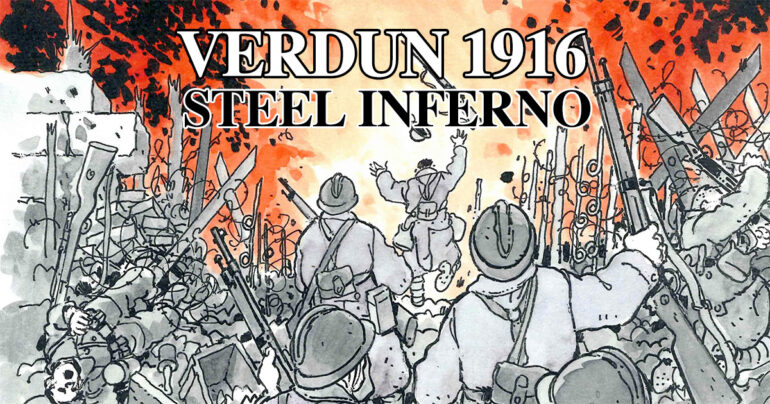

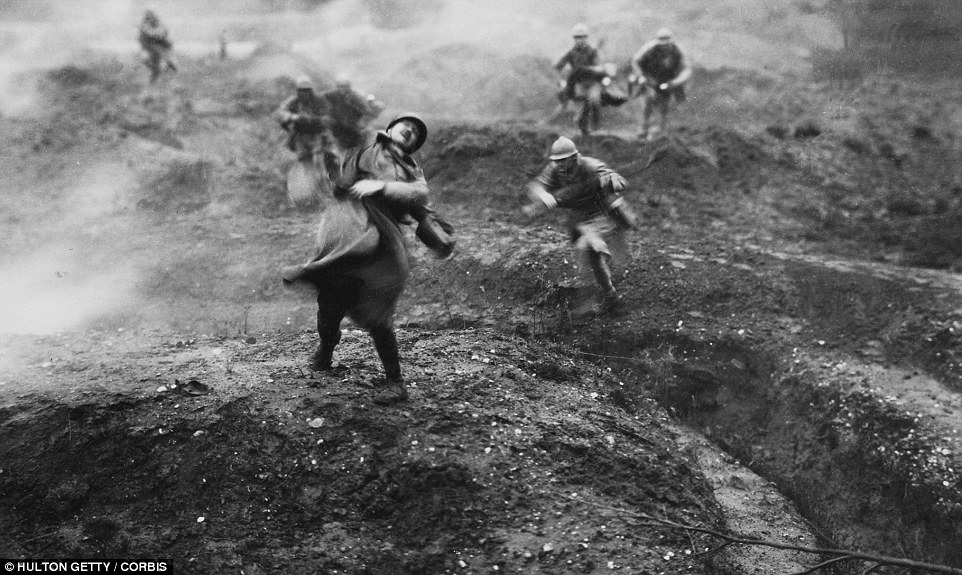
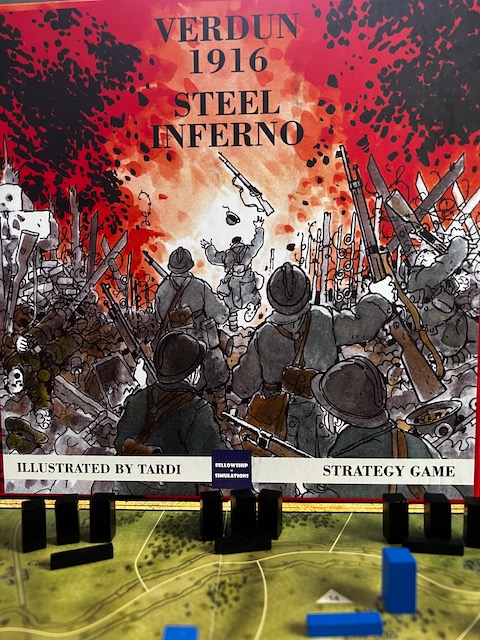
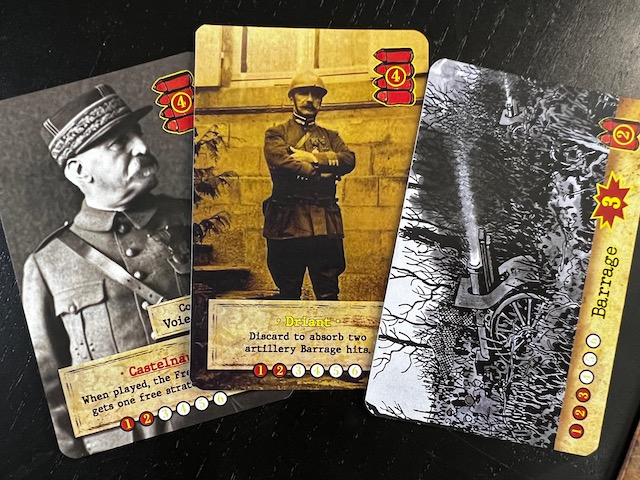
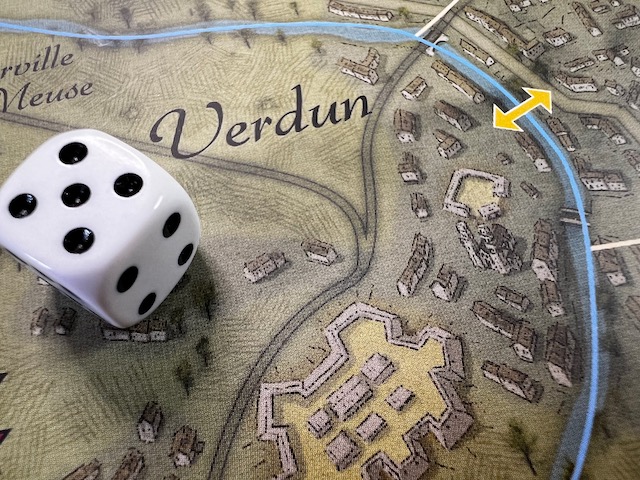
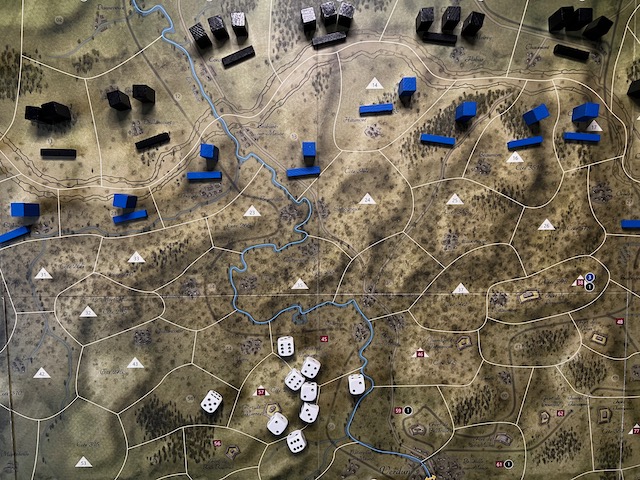
One thing I might suggest to anyone picking up this game is to grab a handful of blue and black cubes that can be used to mark control of a zone.The game comes with a handful but there aren’t really enough to cover the whole line, and it’s handy to be able to see that at a glance.